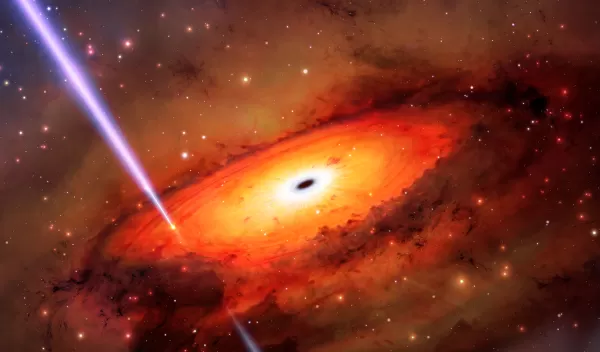
Stellar demolition derby generates powerful gamma-ray burst
While searching for the origins of a powerful gamma-ray burst (GRB), an international team of astrophysicists may have stumbled upon a new way stars might be destroyed.
Although most GRBs originate from exploding massive stars or neutron-star mergers, the researchers concluded that GRB 191019A instead came from the collision of stars or stellar remnants in the jam-packed environment surrounding a supermassive black hole at the core of an ancient galaxy. The stellar demolition derby points to a long-hypothesized but never-before-seen way to demolish a star and generate a GRB.
"This is exciting for understanding how stars die and for answering other questions, such as what unexpected sources might create gravitational waves that we could detect on Earth."
Led by Radboud University in the Netherlands, the research team included astronomers from Northwestern University. The study, published in Nature Astronomy, was supported in part by several grants from the U.S. National Science Foundation, listed at the conclusion of this article.
"For every hundred events that fit into the traditional classification scheme of gamma-ray bursts, there is at least one oddball that throws us for a loop," said Northwestern astrophysicist and study co-author Wen-fai Fong. "However, it is these oddballs that tell us the most about the spectacular diversity of explosions the universe is capable of."
Added Northwestern astrophysicist and study co-author Giacomo Fragione, "This remarkable discovery grants us a tantalizing glimpse into the intricate dynamics at work in these cosmic environments, establishing them as factories of events that would otherwise be deemed impossible."
Most stars die, according to their mass, in one of three predictable ways. When relatively low-mass stars like our sun reach old age, they shed their outer layers, eventually fading to become white dwarf stars. More massive stars, on the other hand, burn brighter and explode faster in cataclysmic supernovae explosions, creating ultra-dense objects like neutron stars and black holes. The third scenario occurs when two such stellar remnants form a binary system and eventually collide.
But the new study finds there might be a fourth option.
"Our results show that stars can meet their demise in some of the densest regions of the universe, where they can be driven to collide," said lead author Andrew Levan, an astronomer with Radboud University. "This is exciting for understanding how stars die and for answering other questions, such as what unexpected sources might create gravitational waves that we could detect on Earth."
On October 19, 2019, NASA's Neil Gehrels Swift Observatory detected a bright flash of gamma rays that lasted a little more than one minute. Any GRB lasting longer than two seconds is considered "long." Such bursts typically come from the collapse of stars at least 10 times the mass of our sun.
The researchers then used the Gemini South Telescope in Chile — part of the International Gemini Observatory operated by NSF's NOIRLab — to make long-term observations of the GRB's fading afterglow.
By working to discover more of these events, the researchers hope to match a GRB detection with a corresponding gravitational-wave detection, which would reveal more about their true nature and confirm their origins — even in the murkiest of environments. The Vera C. Rubin Observatory, when it comes online in 2025, will be invaluable in this kind of research, scientists said.
NSF supported the research through the following grants: AST-1814782, AST-1909358, AST-2047919, and AST-2108624.
The research is also based on observations obtained at the international Gemini Observatory, a program of NOIRLab, which is managed by the Association of Universities for Research in Astronomy under a cooperative agreement with NSF on behalf of the Gemini Observatory partnership. Along with NSF, the partnership includes the National Research Council (Canada), Agencia Nacional de Investigación y Desarrollo (Chile), Ministerio de Ciencia, Tecnología e Innovación (Argentina), Ministério da Ciência, Tecnologia, Inovações e Comunicações (Brazil) and Korea Astronomy and Space Science Institute (Republic of Korea).
The data were processed using the Gemini IRAF package and DRAGONS, Data Reduction for Astronomy from Gemini Observatory North and South, NSF grant AST-1238877.
